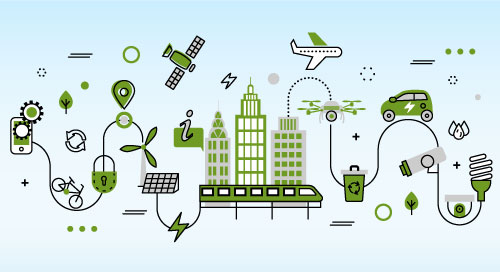Find New Markets With AI and Video Analytics

Growing any business can mean many things, but ultimately it almost always involves expanding a customer base. Unlike in many other industries, IoT developers can often leverage their underlying technology to address new applications and markets.
And while applications are different on the surface, the ability to adapt common techniques and methods has given developers a chance to readily expand their market reach. The intersection of AI and video analytics offers a prime example.
Machine learning and pattern recognition, combined with video, have enabled automation of informational tasks—resulting in faster operations with improved reliability. And edge computing offloads processing from data centers to cameras that use a range of light spectra to gather different types of information.
“CCTV cameras have long been deployed, for example, across cities, inside buildings, and throughout airports,” says Abhijit Shanbhag, CEO of cognitive multimedia analytics company Graymatics. “And they have typically been used with a security guard looking at video screens once in a while.”
But the power of video is a lot more than just security. It can help streamline operational processes as well. With the proper software, cameras can provide a range of data, from helping enhance customer experiences to improving quality on a factory line.
The ability to gather the data is already there. Adaptation and redirection of existing software is what opens up new opportunities.
CV and AI Technologies Are Key
The company’s cloud-based G3C.AI software analyzes video streams to quickly identify and examine potential issues, anomalies, or events of interest. It takes in real-time streaming protocol (RTSP) video feeds and processes them—returning analysis to a dashboard or alert.
APIs and libraries provide developers and end users access to the platform’s video analytics capabilities. Then a set of tools allows rapid development of graphical user interface elements.
An example of incorporating new customer audiences starts in building management. Automated parking control uses cameras and edge computing to process images of vehicle license plates, check a database of permitted users, monitor availability of open spaces in real time, and allow access to authorized persons.
Those basic capabilities are also required in seemingly unrelated applications. Authorizing access to parking is similar to facility access control. Counting people moving through a building is akin to watching how they move through a retail store. And identifying use of hard hats and safety shoes in construction areas isn’t far off from spotting visual defects in products moving down an assembly line.
Graymatics’ ability to innovate by shifting fundamental technologies to different but similar applications shows how developers can grow across verticals, such as smart cities, factories, and retail.
“Once we’re talking about areas like malls, there was a natural progression to using our analysis in each of the retail outlets in the malls,” Shanbhag says. “Building companies wanted the capabilities for their campuses. From campuses, the range of analytics moved to smart cities, because there was a lot of overlap in the analysis required. Buildings led to construction sites within them, and some of the buildings were factories, which needed analogous types of automations.”
Graymatics has developed a highly flexible AI platform by leveraging powerful algorithms, deep learning technology, and intelligent video analytics. via @insightdottech
Great Platform with Great Partners
Fundamental to the type of expansion, Graymatics has undertaken an appropriate platform that abstracts problems. To keep economic efficiency, developers must avoid reinventing the wheel. A platform provides as much of the common core of functions as possible.
Graymatics can meet a variety of needs through such tactics. One is swapping AI modules for processing video to achieve a different use case, even though the basic concepts, and possibly much of the code, are the same ones the company leveraged elsewhere. Another is to add global support for new hardware or general capabilities so that all applications have access.
A platform is only as powerful as the ecosystem it uses. “We have our software optimized on Intel® technology, such as the Intel® OpenVINO™ Toolkit, Intel® Movidius™ VPUs, and the IEI TANK AIoT Developer Kit,” says Shanbhag. “G3C.AI is compatible with many databases, video storage systems, and other tools to allow greater compatibility with existing infrastructures.”
Also critical are partners, like value-added resellers, systems integrators, and distributors. Because Graymatics addresses only AI-powered video analysis, it retains flexibility to shift to new applications by working with appropriate other companies.
The company looks for partners that work closely with Intel. “That has helped accelerate our access and build some very good traction in various geographies, which might not have been a top priority initially,” Shanbhag says.
The specific process the company uses to address new verticals varies with the nature of the market. In smart cities, for example, Graymatics works with master systems integrators and server partners. Devices and applications use the G3C.AI APIs for access to the specific algorithms they need.
But for a retail store, there are fewer layers of partners. Instead, Graymatics asks for the RTSP links for video feeds from cameras in the store and then moves the feeds into its cloud systems. The company would then provide the retailer with a URL address that contains dashboards that have the data to answer specific questions. “For instance, how much time did a female customer, age 30 to 35, spend in front of a specific product display inside their store?” Shanbhag says.
By working smart, leveraging partners, and recognizing how to apply previously solved problems in new applications, a software company like Graymatics can find new markets around the world.